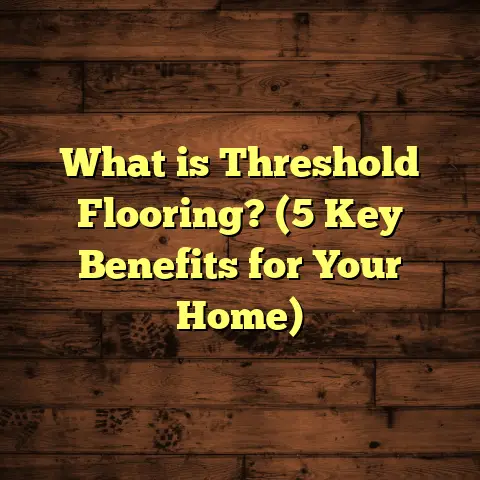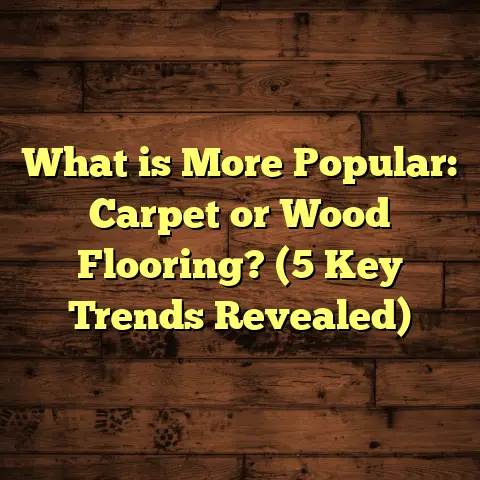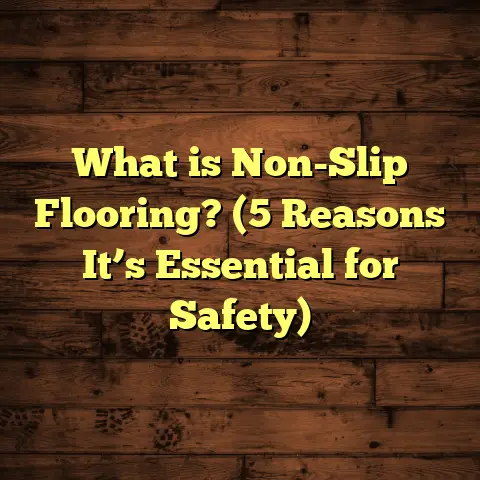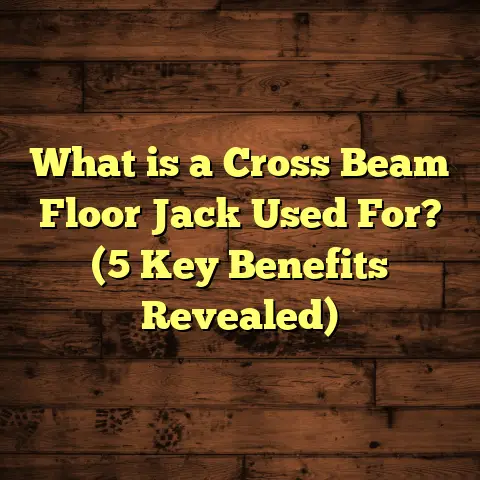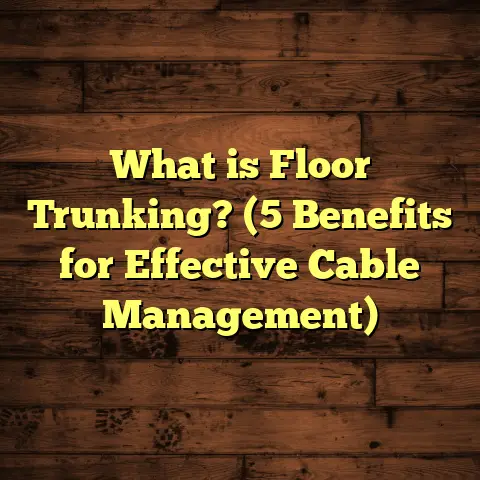What is Polyurea Floor Coating? (5 Benefits for Durability)
Eco-consciousness has become a huge part of how I think about flooring these days. More people want solutions that don’t just look good or last long but also reduce environmental impact. It’s a shift that feels really positive — kind of like we’re making smarter choices for our homes and our planet. When it comes to durable floor coatings, one product I keep coming back to is polyurea floor coating. I’ve worked with it on multiple projects, and honestly, it’s impressive how it balances toughness with being a greener option.
If you’re curious about what polyurea is, why it’s so popular, and how it could fit your needs, stick with me. I’ll walk you through everything — from the basics to some insider tips you won’t find in typical product descriptions.
What Is Polyurea Floor Coating?
So, let’s start with the basics: what exactly is polyurea floor coating?
Polyurea is a type of spray-applied floor coating made from a chemical reaction between an isocyanate and a synthetic resin blend (usually an amine-based resin). This reaction creates a tough, waterproof, highly flexible film that bonds tightly to surfaces like concrete. It’s part of the broader category of elastomeric coatings but stands out due to its fast curing time and exceptional durability.
I explain this to clients by comparing it with something they might know better — epoxy. Epoxy coatings have been around for decades and are widely used on garage floors, warehouses, and even residential basements. They’re strong but often rigid and prone to cracking over time, especially in environments with temperature fluctuations or constant heavy traffic.
Polyurea changed the game because it cures incredibly fast — often within seconds to minutes — and offers much more flexibility. This means it can handle expansion and contraction in your floor without cracking or peeling.
How Polyurea Is Applied
The application process is quite technical. Polyurea components are stored separately and then combined at a spray nozzle under high pressure. This causes an almost instantaneous chemical reaction that forms the coating layer. Because of this quick set time, polyurea requires specialized spray equipment and trained installers who can work quickly and precisely.
I remember my first polyurea job vividly — the installer had to move fast, spraying large sections without stopping because once mixed, the material hardens almost immediately. It felt like watching a well-choreographed dance between man and machine.
Differences Between Polyurea and Other Coatings
- Epoxy: Cures slower (12-72 hours), rigid when cured, prone to yellowing under UV light, moderate chemical resistance.
- Polyurethane: More flexible than epoxy but slower curing time, moderate UV resistance.
- Polyurea: Ultra-fast curing (seconds), highly flexible (up to 400% elongation), excellent UV and chemical resistance.
Because of these traits, polyurea is perfect for:
- Garages and industrial floors
- Outdoor patios and walkways
- Warehouses with heavy machinery
- Commercial kitchens and automotive shops
Five Benefits of Polyurea Floor Coating for Durability
I’ve installed dozens of polyurea floors over the years, and certain benefits stand out clearly. Let me break down the top five durability advantages I’ve seen firsthand.
1. Fast Curing Means Minimal Downtime
One of the biggest frustrations clients have with traditional floor coatings is the wait time. Epoxy floors can require up to three days before you can walk on them, sometimes longer before heavy traffic is safe. That’s a big inconvenience for homes with active families or businesses that rely on their floors daily.
Polyurea changes the timing game completely.
Because it cures in minutes rather than hours or days, you can have your floor coated in the morning and be walking on it by lunch. This rapid turnaround means less disruption — whether it’s a busy warehouse or your home garage.
Here’s a real-world example: I worked with a client who runs a busy automotive shop. They needed their floor recoated but couldn’t afford downtime because they’d lose revenue every hour they were closed. With polyurea, we applied the coating overnight, and they reopened on schedule without any issues.
Data point: Industry reports show polyurea cures up to 10 times faster than epoxy coatings.
2. Flexibility Prevents Cracks and Peeling
Concrete naturally expands and contracts due to temperature changes or settling over time. A rigid coating will crack under this movement, causing unsightly damage and sometimes costly repairs.
Polyurea’s elasticity is one of its most remarkable features. It can stretch up to 400% before breaking, compared to epoxy’s 50-100%. This means it moves with your floor rather than against it.
In a warehouse facility I serviced, the concrete slabs had multiple joints that shifted regularly due to temperature differences. The old epoxy floors cracked badly within a year of installation. After switching to polyurea coatings, the floors showed almost no cracks even after three years of heavy forklift traffic.
Statistic: Polyurea coatings provide 4x more elongation than epoxies.
3. Outstanding Resistance to Chemicals and Abrasion
If you have floors exposed to harsh chemicals like oils, solvents, acids, or industrial fluids, durability goes beyond just resisting cracks. Your coating needs to withstand spills without degrading or staining.
Polyurea creates a strong chemical barrier that resists these substances effectively. This makes it ideal for automotive shops, factories, laboratories, and even commercial kitchens where cleaning agents are frequently used.
For instance, one automotive repair shop I worked on had frequent oil spills that destroyed their previous coating quickly. The polyurea floor held up impressively for over two years without any visible damage or discoloration.
4. UV and Weather Resistance for Outdoor Floors
Many floor coatings degrade quickly when exposed to sunlight because UV rays cause yellowing, chalking, or brittleness over time. If you want an outdoor patio, pool deck, or sun-exposed garage floor that stays looking fresh year-round, UV resistance is crucial.
Polyurea coatings resist UV damage much better than epoxies and many urethanes. I’ve seen patios in sunny climates retain their color and finish for 4+ years without fading or cracking.
One client in Florida wanted a decorative patio floor that could withstand intense sun and rainstorms. After applying polyurea coating, their patio stayed vibrant and intact for multiple seasons despite harsh weather exposure.
5. Environmentally Friendly Compared to Other Options
This benefit resonates with me personally because I try to recommend products that align with eco-conscious values whenever possible. Polyurea coatings generally emit fewer volatile organic compounds (VOCs), which are harmful chemicals released into the air during application.
They also require thinner layers compared to epoxies while providing equal or better protection — meaning less material use overall.
Faster curing also means less energy consumed during installation because there’s no need for climate-controlled drying rooms or long ventilation periods.
Research insight: Studies show polyurea systems can cut carbon footprint by up to 30% compared to traditional epoxy coatings over the lifecycle of flooring projects.
Tips From My Experience for Getting the Best Results With Polyurea
Surface Preparation Is Key
No matter how great a coating is on paper, if your surface isn’t prepared properly, it won’t stick or last long. Concrete should be clean of oils, dirt, paints, or sealers. It also needs to be dry because moisture can cause bubbling or lifting after application.
I always recommend diamond grinding or shot blasting the concrete surface before applying polyurea — it roughens up the surface enough for strong adhesion without damaging the slab.
Control Moisture Levels
High humidity or wet concrete slabs are enemies of good adhesion. Always test moisture vapor emission rates before application using reliable meters.
If moisture levels are too high, solutions like moisture mitigation primers can help but add extra steps and costs.
Use Professional Spray Equipment
Polyurea cures so quickly that spraying by hand or rolling isn’t practical. Specialized high-pressure plural component spray machines are essential for proper mixing at the nozzle and uniform application.
If you’re thinking about DIY polyurea kits — they exist but usually work only for small patches or touch-ups because they don’t achieve professional quality finishes over large areas.
Timing Is Everything During Application
Installers need to work quickly but carefully because once mixed, polyurea sets fast — sometimes within seconds depending on temperature and humidity conditions.
This fast set means less chance for dust contamination or uneven spreading if done right but also little room for mistakes. Experienced professionals know how to pace themselves based on environmental conditions.
Choose Colors and Textures Wisely
Polyurea coatings come in many colors, including metallic finishes or decorative flakes embedded in the top layer for added texture and appearance.
I often suggest clients pick something that complements their space’s design but also hides dirt well if used in high traffic areas like garages or workshops.
My Story: Why I Recommend Polyurea Over Other Coatings
Let me share a personal story about why I’m such a fan of polyurea now.
A few years ago, a family contacted me about coating their basement floor. They had tried epoxy before but were disappointed by its strong odor during installation and tendency to chip after only six months — not ideal for a basement where kids play and pets roam freely.
We decided on polyurea because it has low VOC emissions (so less smell) and superior durability. The process was quick; we finished in one day with minimal disruption.
Over two years later, their basement still looks great — no chips or cracks despite lots of foot traffic, toys dropped on the floor, and even some minor flooding that cleaned up easily thanks to polyurea’s water resistance.
They told me the peace of mind was worth every penny spent upfront.
What Does Data Say About Polyurea Floor Coatings?
I’m always looking at real numbers when recommending flooring solutions:
| Property | Polyurea Coating | Epoxy Coating |
|---|---|---|
| Cure Time | 5 minutes | 24-72 hours |
| Elongation at break | Up to 400% | 50-100% |
| Tensile Strength | ~2,500 psi | ~2,000 psi |
| Abrasion Resistance | 3x higher than epoxy | Baseline |
| Chemical Resistance | Excellent (oil/solvents) | Moderate |
| UV Resistance | High | Low (yellowing common) |
| VOC Emissions | Low | Moderate-high |
| Typical Thickness | 20-40 mils (0.5-1 mm) | 30-60 mils |
| Expected Lifespan | 10+ years (industrial) | 5-7 years |
These numbers back up what I’ve seen on actual jobs: polyurea lasts longer under tough conditions with less maintenance required.
Frequently Asked Questions About Polyurea Flooring
Q: Is polyurea suitable for residential use?
Definitely! While often used commercially due to its durability, polyurea works great in homes — garages, basements, patios — anywhere you want a tough surface.
Q: How much does polyurea coating cost?
Costs vary based on project size, location, prep work needed, and finish chosen but expect roughly $7-$12 per square foot installed. This is higher than epoxy ($3-$7) but lower lifetime maintenance often balances things out.
Q: Can polyurea be recoated?
Yes! You can apply new layers over existing polyurea floors if properly cleaned and prepped — great for refreshing appearance after several years.
Q: How long does polyurea last?
With correct installation and care, polyurea floors can last 10+ years even in heavy industrial settings.
Final Thoughts on Polyurea Floor Coatings
If you want a floor that:
- Sets fast so your life won’t stop,
- Moves with your concrete without cracking,
- Resists chemicals like oils without fading,
- Stands tough under sun exposure outdoors,
- And supports greener building practices,
then polyurea should be high on your list.
It’s not always the cheapest upfront but pays off by lasting longer with fewer repairs or replacements needed over time.
I’ve seen so many clients thrilled with their polyurea floors years after installation — looking brand new despite daily wear-and-tear. That kind of peace of mind is priceless in my book.
Want help figuring out if polyurea fits your project? Feel free to ask! I’m always happy to share tips or recommend trusted installers who do this right every time.
Thanks for sticking with me! What questions do you have about polyurea? Or maybe you’ve tried other coatings — how did those work out? Let’s chat!
